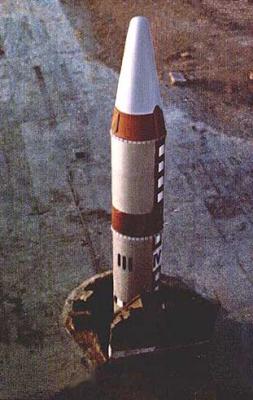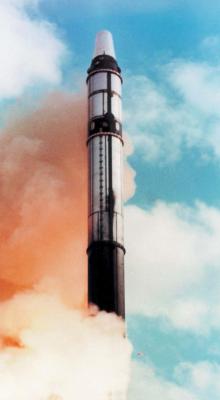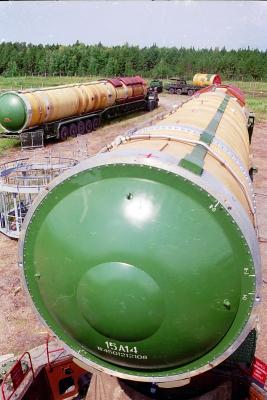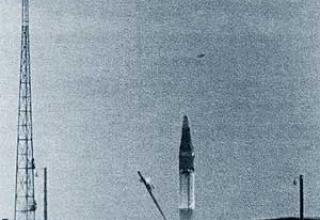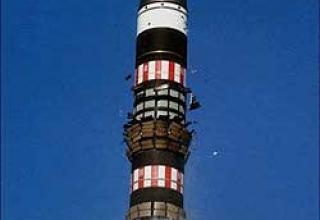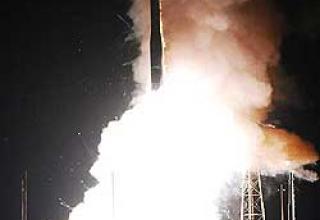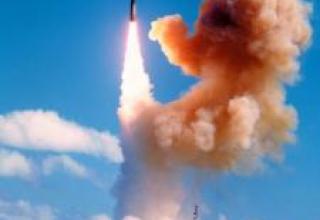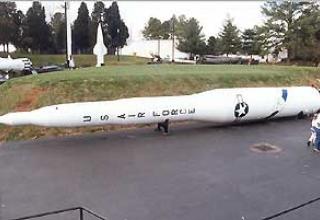The 15P014 Strategic Missile System (R-36M) with the 15A14 heavy ampoule intercontinental strategic missile (ICBM) and the 15P714 enhanced protection silo launch vehicle of the third generation was created at Yuzhnoye Design Office (Dnepropetrovsk) under the leadership of V.Utkin.
Flight tests of the rocket for the purpose of development of launch parameters began in January 1970, flight tests have been conducted since February 21, 1973.
Monoblock version of R-36M missile was adopted in service on November 20, 1978. On November 29, 1979 the upgraded 15A14 ICBM with 15F143U head unit was adopted for service as part of 15P014 complex. The first missile regiment with the R-36M ICBM was put on combat duty on December 25, 1974. (Dombarovsky, commander N.I. Korgonenko).
In December 1972, the KBSM in accordance with the Decree of the Government of the USSR was developed a project of the launch complex 15P014P enhanced protection. The solution of the problem of enhanced security was made possible thanks to the prospects of the main circuit design solutions and the optimality of the overall PU layout. The Rocket Regiment with the SPU of enhanced security started the combat duty on November 30, 1975. (UAH Dombarovsky, commander A.D. Grigoriev). The maximum number of rockets deployed was in 1979 (Dombarovsky, commander A.D. Grigoriev). - 190 units.
The implementation of progressive technical decisions taken during the development of the R-36M made it possible to create the world's most powerful combat missile system, surpassing the previous R-36 system:
- in terms of firing accuracy - 3 times;
- in terms of combat readiness - 4 times;
- in terms of the missile's energy capabilities - 1.4 times.
- by the safety of the launcher - 15-30 times;
- in terms of using the PU volume - 2.4 times;
- for the initially set warranty period of operation - 1.4 times.
In 1980, the 15A14 missiles on combat duty were re-equipped without the need to extract from the slide control system improved RSH with liquid guidance stage, created by then for the missile 15A18. Under the new designation 15A18-1, the missiles continued on active duty for 10 years or more beyond the warranty period.
In 1982 the missiles continued their combat duty for 10 years or more beyond the warranty period. R-36M ICBMs were taken off duty and replaced by R-36MUTTX (15A18) missiles.
The R-36M ICBM was designated SS-18 mod 1,2,3 "Satan" (RS-20A) in the west.
Composition:
The two-stage R-36M missile was made in tandem with sequential separation of upper stages, and structurally included the first, second and combat stages. The body of the first stage consists of a transitional compartment, fuel cell, side protection of the propulsion system and a pallet. The second stage enclosure has a fuel compartment and a heat shield. The oxidizer and fuel tanks are separated by an intermediate combined bottom. Along the missile body there are pneumatic-hydraulic system pipelines and onboard cable network, covered with a casing.
Dry compartments were excluded from the 15A14 missile, except for the stage II interstage adapter. An all-welded fuel cell was used for stage II of the missile. The "T" tank has a cavity in which the main engine of stage II is located. The adjacent bottoms of stage I tanks are equidistant, while the bottom bottoms of stage I fuel tank are concave (to seal the layout of the stage I remote control). All this allowed, while maintaining the diameter and some (400 mm) reduction of the total length of the first two stages of the rocket, compared to 8K67 rocket, to increase the fuel stock by 11%.
The main engines of both stages are made on the closed circuit, with high pressure in chambers. The I stage is equipped with a remote control (RD-264) consisting of four single-chamber 15D117 engines developed by KBEM (Chief Designer - V.P. Glushko) hinged to the frame in the tail part of the stage. Deviation of the engines at the command of the control system provides flight control of the rocket. Stage II control consists of the main single-chamber engine 15D7E (RD-0229), placed inside a toroidal fuel tank and four-chamber steering engine 15D83 (RD-0230) open circuit development KBHA (thrust in the void - 90 tons).
In the pneumohydraulic scheme (PHS) of a rocket a number of essentially new decisions have been realised, allowing to simplify considerably a design and the scheme of work of PHS, to reduce quantity of elements of automatics, to exclude necessity of carrying out of preventive works with PHS and to raise its reliability at weight reduction. Features of the PGS rocket are complete amputation of rocket fuel systems after refueling with periodic control of pressure in tanks and the exclusion of compressed gases from the side of the rocket. This allowed to increase the time of staying of the RK in full alert up to 10-15 years with the potential of operation up to 25 years.
For pre-injection of tanks, a chemical boost scheme was developed and implemented for the first time - by injecting the main fuel components into the liquid mirror in the fuel tanks. The "hot" supercharging of oxidizer and fuel tanks (T=450±50°C) with regulation of ratio of components to gas generators was introduced. Separation of the 1st and 2nd stages - gas-dynamic according to the cold scheme was provided by operation of breakaway bolts, opening of special windows and flow through them of supercharging gases in fuel tanks.
An autonomous inertial control system was installed on the missile, and its operation was provided by an onboard computer system. Successfully selected and successfully implemented complex of computational characteristics (capacity 16, RAM 512-1024 words, ROM 16 K words, the speed of 100 thousand operas / sec.), reliable element base provided this on-board computer unique life - about 25 years, and its somewhat modernized version is in operation on duty and now. To increase the reliability of the BCVC all its main elements were redundant. During the combat duty the onboard computer provided information exchange with ground devices. The most important parameters of the missile's technical condition were controlled by the control system. Application of BCVC made it possible to achieve high firing accuracy. CWO of the falling points of combat units was 430m. The control system was developed by Khartron Design Bureau; the manufacturer was NPO Khartron.
The missile's circuit diagrams and control systems were developed on the basis of the condition of the possibility to use three versions of the MS (including the most powerful special charge - 15F141 MS):
- Lightweight monoblock (with a charge of 8Mt) with a range of 16000 km (see diagram);
- Heavy monoblock (with 20Mt charge) with a range of 11200 km;
- Splitting HF (SHF) (see diagram) in two sets:
- 10 combat units with 0.4 Mt of charge.
- or 4 combat units with a 1.0 Mt charge and 6 combat units with a 0.4 Mt charge.
One of the most difficult tasks was to choose the principal scheme and characteristics of the dividing head unit - a fundamentally new type of missile combat equipment. Based on the analysis of different variants of the schematic diagram and the flight pattern of the RSH was adopted in the design of the head unit with an autonomous remote control. The dividing head unit is made unified for three versions of its combat units and received the designation 15F143U. When creating the first multi-reactor warheads with individual pointing of combat units (BC), the problem of selecting the type of remote control (LRD or TTRD) for redirection and building combat orders of BC and false targets was solved. The preference was given to TTRD that meets the requirements on energy mass parameters, compatibility at "different caliber" composition of the UAV and has certain operational advantages.
Yuzhnoye Design Office and NPO Altai have developed two modifications of the RFC - 15D161 and 15D221, in the design of which the following fundamentally new solutions were implemented:
- partially bonded to the body of end combustion charges on the basis of elastic non-metallic low-temperature mixed solid fuels, which allowed to provide mass perfection, the required long operating time and acceptable conditions for the operability of controls;
- high-efficiency (maximum control force up to 45% of the axial thrust) low-torque rotating controlled nozzles, which allow for complex evolution of the RSH in space and do not require a steering unit with excessive mass.
All missile head units are equipped with an advanced missile defense system developed at CNIRTI. Quasi-heavy decoys have been created for the first time for the 15A14 missile anti-missile defense system, which allows to simulate the characteristics of combat units practically by all selection features on the extraatmospheric section of the trajectory and a significant part of the atmospheric section. On the descending AUT, the movement of the booster is simulated due to the use of a special solid propellant engine "acceleration", which has no analogues in world practice, progressively (20 times) increasing thrust of which compensates the force of aerodynamic braking of the false target.
One of the radical technical solutions on the complex 15P014, which largely determined the high level of its characteristics, was the use of mortar launch rocket from the TIC. For the first time in world practice, a heavy liquid-propellant ICBM mortar launch scheme was developed and implemented. Powder pressure accumulators with progressive and stable performance characteristics created by Yuzhnoye SDO and LNPO Soyuz allowed to obtain optimal modes of missile motion during the launch from the industrial complex and at the initial section of the trajectory. At the same time, the required law of gas pressure change in the submarine space was provided by monoblock charges with progressive combustion surface and a scheme of several successively operating PADs.
For the missile 15A14 KBSM there were created highly protected mine launchers 15P714 on the basis of the launch vehicle "OS-67" 8K67 missile by hardening the construction part of the structure, replacing the metal structures of the barrel and the headband, installing a new protective roof PU and depreciation system. The PU design provides for its construction (or reconstruction of PU "OS-67") by industrial methods with the use of common building materials - precast concrete, structural steels.
The missile is operated in the TIC 15Я53. The complete assembly of the missile, its docking to the systems placed at the Industrial Complex, and checks are performed at the manufacturing plant. The industrial complex is equipped with a passive system for maintaining the missile's moisture regime while it is in the booster station. The casing of the industrial complex is made of high-strength fibreglass plastic. The operation of the missile in the Industrial Complex and the use of a mortar launch scheme allowed:
- to eliminate the need for a launcher header;
- to simplify the issues of amortization of the ground check and launch equipment by placing it on the amortization TIC;
- to provide more complete use of the launcher volume; to simplify significantly the design and reduce the internal diameter of the PU by eliminating the inner cup, gas ducts, gas swirl grids;
- reduce the amount of work on the PP, as well as reduce the time for putting the complex on combat duty and carrying out routine maintenance work.
The system of amortisation of TPK in ШПУ - pendulum type, horizontal - two-belt with hydrodampers, vertical - with the pneumatic shock-absorber equipped with a rubber-cord cover (РКО) of a tore type. To ensure greater reliability and tightness, the RKC unit consisted of two elements: a power RKC and a sealing chamber, which was obtained from pure butyl rubber injection molding. Sealing chamber was inserted into the power recirculating unit, and its sides (external and internal) were vulcanized to the plunger and shock absorber body. The shock absorber was designed as an ampoule with a single filling port, which was welded after filling the shock absorber with compressed nitrogen. The static force of the shock absorber was 140 tf (static pressure 53.6 kgf/cm2). The damper force was controlled by three DORM-50 tensile dynamometers, which were installed between the ram and housing. In the subsequent modification of the pneumatic shock absorber the filling connection was not welded, and after filling the pneumatic shock absorber in the cavity of the filling nozzle a hydraulic shutter was created. The pressure of the air shock absorber could be checked repeatedly with a special device fitted to the filling connection. In such a version, the pneumatic shock absorber was used in the shock absorber systems of the 15P014 complex and in the subsequent BSC for the R-36M missile and its modifications, up to the present time.
The rocket placed in the transport and launch container was placed in the silo launcher and could be on combat duty for a long period of time in the fueled state.
Preparation for launch and launch of the rocket were carried out automatically after receiving the launch command control system. The most important parameters of the missile were under constant control, which increased the reliability of the combat mission. To prevent unauthorized use of nuclear weapons, the control system accepted only commands with a certain code key. The implementation of such an algorithm made it possible to introduce a new centralized control system at all command posts of the Strategic Missile Forces.
The combat application of the system was provided in any weather conditions, at air temperature from -40 to +50C and wind speed at the ground surface up to 25 m/s, including after the nuclear impact on the missile system.
Characteristics:
| General characteristics | |
| Maximum range of fire, km: - Heavy class HC. - Light Class MS. |
11200 10500 - 16000 |
| Firing accuracy (range 10000 km), km | ±1.6 |
| Generalized reliability indicator | 0.91 |
| Launch time from full alert, sec | 62 |
| Rocket's resistance to harmful factors of Java in flight | level 1 |
| Warranty period of being on combat duty under the regulations once in 3 years, years | 10 |
| 15A14 missile | |
| Diameter, m | 3 |
| Length (with hCG), m | 33.65 |
| Launch weight of the rocket, shh: - Heavy class HC - with a light class HF - with GHG |
209.2 208.3 210.4 |
| Weight of the head part, kgs: - with a heavy combat unit - with a lightweight combat unit - with 10 combat units |
6565 5727 7823 |
| Weight of fuel, shh: - Stairs I - II stages |
150.5 37.6 |
| Flight Reliability | 0.958 |
| Energy Performance Coefficient Spg/Go, kgf/t | 36.7 |
| Remote Control Features | |
| Traction remote control (on the ground / in the void), ps: - Stairs I - II stages |
424.8/461.2 - / 77.5 |
| Remote control specific impulse (on/in the ground/in the void), c: - Stage I - II stages |
293.3/318.4 - / 325.5 |
| Main engine combustion chamber pressure, kgf/cm2: - Stage I - II stages |
210 |
Testing:
From 1973 to 1975, 5 research institutes conducted flight and development tests of the complex with all types of missile combat equipment. Of the 43 launches, 36 were successful. Refusals at the LKI were due to design flaws and manufacturing defects. The reasons were unambiguously established and eliminated. The actual flight reliability of the missile, taking into account the carried out modifications and measures to ensure the quality of production is 0.958.
The beginning of flight tests was preceded by a large volume of ground testing of new schematic and structural solutions, including throw tests. The successful development of the complex confirmed the correctness and progressiveness of the adopted technical solutions.
The variant of rocket with separating head part from 8 blocks came out on tests in 1975. Monoblock HC 15B86 with the "light" class BB passed the LKI on missile 15A14 until April 1976 and was adopted in service as part of the missile 15A14 by a separate decree in 1978.
From July 1978 to August 1980, the 15A14 missile carried the experimental homing LCI 15F678 ("Mayak-1") with two variants of sighting (on the radio brightness maps of the terrain and on the relief maps). The 15F678 HF was not adopted for service. There were 95 launches in total.
Sources:
- "Призваны временем. Ракеты и космические аппараты конструкторского бюро "Южное"./ Под общей редакцией С.Н.Конюхова/. Д.: Арт-Пресс, 2004,-232с.
- "КБ специального машиностроения: От артиллерийских систем до стартовых комплексов" (под редакцией Ушакова В.С.) .СПб, 2004.
- Карпенко А.В., Уткин А.Ф., Попов А.Д. "Отечественные стратегические ракетные комплексы", -СПб.: Невский бастион-Гангут, 1999.-288с.
- Колесников С. Г. "Стратегическое ракетно-ядерное оружие". Арсенал-Пресс 1996 год.
- http://www.fas.org
